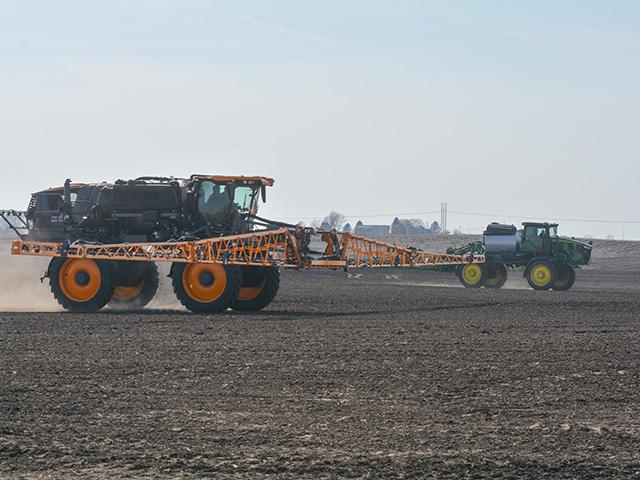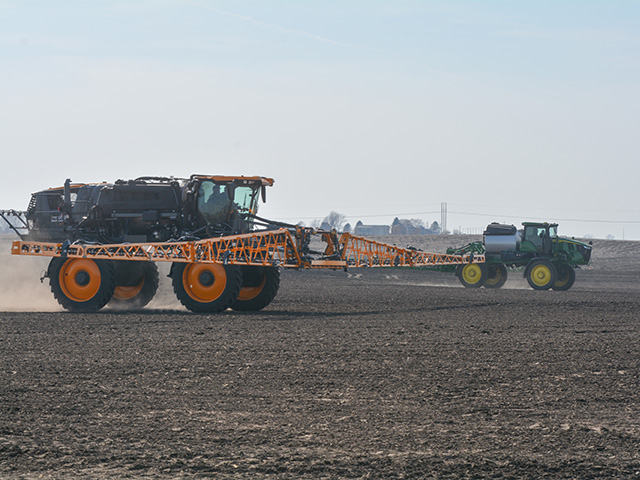MachineryLink
John Deere Improves Technology, Power and Comfort of Select 2022 Models
ANKENY, Iowa (DTN) -- On my family's farm in the 1970s and early '80s, weeds were eradicated from fields via three methods: by hand, a 2-row cultivator attached to a Farmall C or Super C tractor or sprayed using a hand-held wand, a 50-gallon drum full of herbicide and a power take-off-driven pump situated over the hitch of a Farmall C.
John Deere has greatly improved on my family's see-and-pull, see-and-spray and see-and-cultivate method of weed control. The company recently introduced See & Spray Select, which uses camera technology to detect color differences in fields to selectively spray weeds while traveling up to 12 mph in a self-propelled sprayer. It is part of John Deere's largest-ever launch of new equipment and technology.
Read about the equipment and tech rollout here: www.dtnpf.com/agriculture/web/ag/equipment/article/2021/03/02/john-deere-reveals-biggest-equipment.
John Deere hosted a media event on March 9 at its ISG Test Farm near Bondurant, Iowa, to show off its new green goodies. I was lucky enough to attend. Company equipment specialists provided overviews of the following:
-- See & Spray Select and the latest John Deere 400 and 600 series and Hagie sprayers.
-- Updated 8 and 9 series tractors.
-- A 2022 1775 NT planter hitched to an 8RX tracked tractor that together offer 1,600 gallons of liquid fertilizer capacity (600 gallons on the planter).
Media also hopped in the buddy seat of the latest John Deere and Hagie sprayers to experience each in action. However, a spaying demonstration couldn't be done due to high winds.
SPRAYER TECH AND COMFORT
There were easier and better ways to control thistles, waterhemp, marestail and other yield-robbing weeds 40 to 50 years ago than my family's tactics. I mention the past because it's amazing how spraying and other ag technology has progressed in a relatively short amount of time.
There's no perfect weed control system and herbicide tolerance is an on-going threat to agriculture. John Deere, though, continues to develop machines and technology to help keep fields clean in an efficient and economical manner.
P[L1] D[0x0] M[300x250] OOP[F] ADUNIT[] T[]
See & Spray Select is revolutionary. In its current state of development, 36 forward-looking cameras distinguish between brown (soil) and green (weeds in a fallow field). When a weed is detected, that information is sent to several computer processors located on the boom that activate the correct nozzle to spray the weed. The entire process, from weed detection to application, occurs in 200 milliseconds or about the blink of an eye.
Currently, See & Spray is being marketed to small grain producers in more arid regions who manage weeds on fallow acres as part of a regular rotation. Weed pressure is typically not as heavy in those areas.
"Broadcast spraying is overserving their needs," said Kaylene Ballesteros, product marketing manager of See & Spray for John Deere. "That's where See & Spray comes in. It's able to target weeds and reduce herbicide use, on average, by 77%."
She said See & Spray Select pricing will be released in June when farmers can order new sprayers and associated technology.
Eventually, See & Spray Select will be available for row-crop producers for in-season weed control. When that will happen is unknown.
Ballesteros said testing will continue this year to further See & Spray Select development so it can eventually differentiate weeds from crops. In other words, the technology will be able to tell the difference between a green cotton, soybean or corn plant and a green weed. Artificial intelligence and machine learning will be part of the process.
"It (See & Spray Select) will be available as soon as it can be available" for row-crop farmers, Ballesteros said.
See & Spray Select in action, according to product manager Ryan Stien, is "pretty cool."
"From an operating standpoint, it's not much different than broadcast spraying," he added. "The difference is you look at the boom and one nozzle turns on and off and then another. This is the future and we're pretty excited about it."
Sprayer demonstrations featured the 2022 John Deere 412R (1,200-gallon tank, 326-hp PowerTech 9.0L engine) and the 2022 Hagie STS12 (1,200-gallon tank, 300-hp PowerTech 9.0L engine). Neither were short on power or comfort. I was surprised how smooth the ride was in the Hagie as it approached 25 mph in the field.
Farmers and applicators will enjoy the new and larger cab in the 2022 John Deere sprayer models. Depending on the comfort and convenience package selected, a heated and ventilated leather seat that swivels 24 degrees to each side is an option.
"When working long days, the new cab provides increased comfort and visibility," said Hanna Moore, product manager for 400 and 600 series sprayers.
John Deere's acquisition of Hagie enhanced its self-propelled sprayer options for its customers. The front boom placement of a Hagie, compared to John Deere's rear boom, provides a choice for operators who prefer not to be always looking behind the rig during application.
Also, a 2,000-gallon tank on the Hagie STS20 allows operators to work longer between fills.
EFFICIENCY, POWER AND FUCTIONALITY
John Deere's lineup of new 2022 8 and 9 series tractors were impressive. The articulated 9 series, with either wheels, two tracks or four tracks, boasts a stronger frame to accommodate more horsepower and ballast. All 9 series models got a 20-hp boost, ranging from 390 to 640 hp.
Restyled 9 series cabs offer heated, ventilated and massaging seats. I felt like I was in a luxury car rather than a tractor.
The 2022 8RX four-track tractor hitched 2022 1775 NT planter was an attention grabber. The 8RX has two factory-installed 500-gallon ExactRate liquid fertilizer tanks, which John Deere claims is an industry-first -- mounted behind and above each rear track.
"That's 1,000 gallons of liquid fertilizer tucked into the machine that can still carry all that weight below 10 PSI (pounds per square inch of contact pressure on the ground) on the tracks," said Aaron Ticknor, product marketing manager of large tractors for John Deere.
In other words, farmers who apply liquid fertilizer at planting can say good-bye to taking big, bulky saddle tanks on and off each year. The 8RX tanks do not cause visibility issues, which isn't always the case with saddle tanks, and reduce soil compaction worries.
The 1775 NT planter has a factory-installed liquid fertilizer tank that can hold up to 600 gallons. If pulled by the 8RX, each implement provides a total of 1,600 gallons of liquid fertilizer capacity allowing the operator to plant 80 acres between fertilizer fill ups if applying 20 gallons per acre.
"We listen to the challenges producers have and develop solutions," said Joel Dawson, John Deere production and precision ag marketing manager.
Matthew Wilde can be reached at matt.wilde@dtn.com
Follow him on Twitter @progressivwilde
(c) Copyright 2021 DTN, LLC. All rights reserved.






Comments
To comment, please Log In or Join our Community .